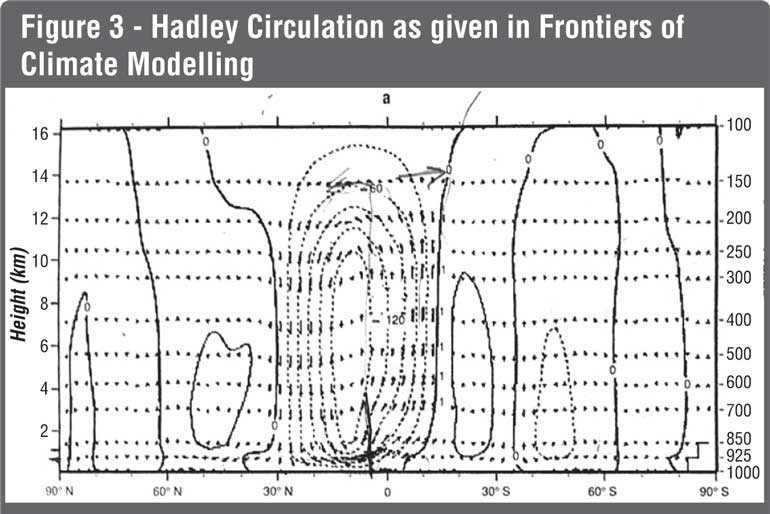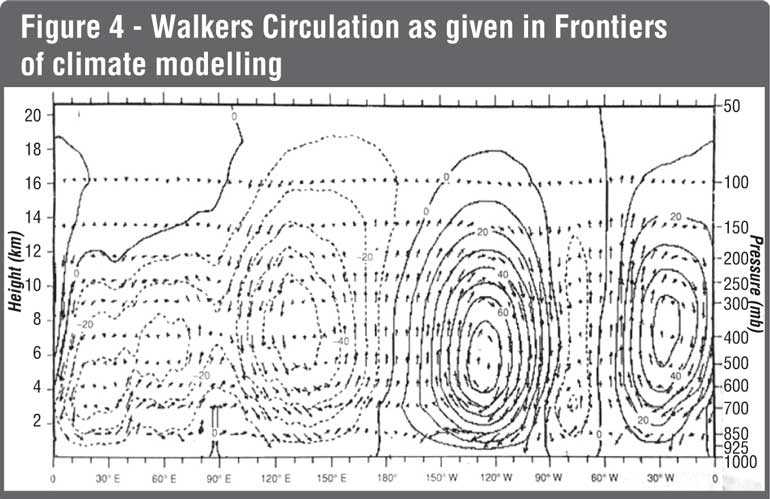Tuesday Nov 25, 2025
Tuesday Nov 25, 2025
Saturday, 10 August 2019 00:00 - - {{hitsCtrl.values.hits}}



The Easter Sunday disaster which occurred at six locations close to the oceanic boundary of the country is said to have been known to the powers who could have acted on that information. Two powerful ministers represent two of the locations closer to Colombo.
A far more dangerous and fundamental vulnerability of Sri Lanka has been brought to the notice of the specific ministry in charge – the Ministry of Environment – but no action has yet been taken.
It was in mid-2018, Muthukumara Mani came to Sri Lanka and presented the report titled ‘South Asia’s Hotspots’ depicting the impact of temperature and precipitation change on living standards, prepared by himself and four other researchers at the World Bank Group. It was received by Secretary to the Ministry and Presidential Advisor Prof. Mohan Munasinghe.
It categorically mentioned that (i) Sri Lanka (No. 1) and Bangladesh (No.2) are the two most vulnerable countries in the region and (ii) High road density is one of the key contributory factors. In January 2018, the Presidential Advisor emphasised that Sri Lanka has nothing to worry about climate change as our per capita GHG emission rate is low. So it has gone unheeded for more than 12 months now and road density is increasing all the time.
We ourselves have been writing to the English dailies for the last few years emphasising about our vulnerability to water vapour and temperature.
Even at that time in mid-2018, Munich Re, the German reinsurer had already enhanced our vulnerability to climate risk from been 98th in 2015 to be fourth in 2016 and nothing had been done or recommended to improve the situation by the Advisor nor the Ministry. Then we became the second most vulnerable country in the 2019 ratings – list published in late December2018, second only to that most vulnerable country, Puerto Rico in the Caribbean with a per capita GDP of $30,000.What happened to Puerto Rico is well known, I presume, to the Advisor and the Ministry. Six months has elapsed since then and we are yet to see any recommendations to improve the situation. Puerto Rico, on the other hand, passed legislation to go in entirely for renewable energy within a matter of four months from Munich Re’s pronouncement in December2018.
Again, Munich Re identified that 80% of the disasters experienced by the 10 most affected countries in each of 2017 and 2019 listings were there due to precipitation.
Prof. Mohan Munasinghe has just published his latest book ‘Sustainable Economics in the 21st Century’. In the latter part of the introduction, Prof. Munasinghe summarises his final opinion as “although the problems are serious, an effective response can be mounted, provided we begin immediately”. Since the book was launched only in mid-May2019, we would probably see some recommendations from our Advisor, as to what we should do and I suggest the Ministry obtains these recommendations and action them immediately.
Why climate change
Generally, explanations of climate change start by referring to the diagram– Figure 1– and all these are energy flow rates. We need to remember that none of these energy flow rates remain constant. The energy budget at the top of the atmosphere itself changes. Incident solar radiation (342 W/m2) changes according to an 11-year solar cycle and reflected solar radiation too (107 W/m2) changes due to what we do (a) to the atmosphere – more cloud formation, etc. – and (b) to the surface -- deforestation, highway construction, etc. What we send out (235 W/m2) is the net result of all others.
Then there are the energy flows emitted at ambient temperature (390W/m2) and therefore, infrared and therefore gets reflected by GHGs. It is the enhancement of energy reflected back (324W/m2) towards the earth which leads to global warming or the bulk of the temperature component of climate change. We need to remember that the two main gases in the atmosphere, oxygen and nitrogen, are transparent to both incoming solar radiation – ultraviolet due to being emitted at 5000 + 0C– as well as to infra-red radiation coming from the earth at -500C to + 500C, but the greenhouse gases CO2, CH4, H2O (water vapour) are transparent to solar radiation coming in, but not to the infra-red radiation coming from below.
So, this implies that if infra-red radiation from the earth’s surface increases or GHG gases in the atmosphere increases or both these increase, global warming or climate change would increase.
There will be serious and fatal consequences to any omission of (a) climate risk vulnerability and (b) the emitter component in emitter – reflector related explanation of climate change. It is vital because if we don’t address the issues which drove us to be the second most vulnerable country, we might become the most vulnerable country and if we go by how Puerto Rico, the most vulnerable country got itself devastated in 2017, it would not be a pleasant experience.
Why are we so vulnerable?
The most fundamental question that would arise will be, why are we so vulnerable? One would find it difficult to understand why we, with only 148km/100km2 road density and 590t/km2 GHG emissions are so vulnerable while Germany (with 180 km/100km2 road density and 2568 t/km2 GHG emissions) and United Kingdom (with 172 km/100km2road density and 2265 t/km2 GHG emissions) are not so vulnerable. Their rankings in 1997-2016 Climate Risk Vulnerability listing are 23 and 58 respectively.
I believe this is one aspect which has not been addressed adequately in Climate Change literature. The secret behind this enhanced vulnerability of ours is the sphericity of the earth. How this sphericity makes us more vulnerable could be gauged from the sketch and the explanation given below.
Looking at Figure 1, one may think that the incoming energy stream of 342W/m2 is a uniform rate for the entire surface of the earth. As could be seen in Figure 2, it is not so and it varies throughout the year, as shown in the sketch, for countries in the Northern and Southern parts giving an average of approximately 200W/m2 while for countries near the equator it remains at an average value close to 400W/m2 throughout the year. As such, a road surface closer to the equator will absorb (talking about 168Wm-2 in the figure 1) approximately double what would be absorbed by a similar road surface closer to the poles.
Since a road surface receives and therefore absorbs more nearer to the equator, it will also emit more closer to the equator – i.e. the term corresponding to 390 wm-2 in the Figure 1.Because of this, the same GHG concentration near the equator will reflect more than the 324 Wm-2 and gases closer to the poles – say in Germany and UK – will reflect much less. Notice the positions of Germany and UK vis-à-vis Sri Lanka in the sketch a) of figure 2.
Now one should understand although Germany and UK can tolerate higher road densities and GHG concentrations, we in Sri Lanka, closer to the equator can’t live with the same values for the two parameters.
What happens to this energy?
The next question that would arise is what happens to this energy stream which got reflected by the GHGs. In all probability it will get reflected down, get absorbed by a surface and reemitted again and so on until the energy stream falls on the ocean. Of course, at each of such interactions, the outgoing energy stream will be less than the incident energy stream due to some inefficiencies, etc.
What happens to solar energy that falls onto the oceans? Ocean differs from solid parts on earth’s surface in that (1) water has a higher specific heat, (ii) it can also transfer heat by convection to lower layers and (iii) the oceanic water that gets heated up can and does flow towards the poles taking away the heat. Due to these characteristics, ocean has a layer called thermocline of about 750m thickness (may be even 1,500 m) at the top of the ocean which is at a much higher temperature than the balance parts of the ocean. The upper layer of the ocean near the equator flows towards the poles, gets cooled, goes down and then comes back towards the equator at a depth and this circulation goes on continuously storing energy. Estimates indicate that about 97% of the energy which gets stored in terrestrial locations are in the oceans.
Because of (i) this ability to (a) flow towards the poles taking the heat away with it and (b) going deeper and (ii) high specific heat, the surface temperature of the ocean is not as high as the land surfaces receiving solar radiation at same intensities.
But when virgin land surface gets cleared and a black road surface is created instead, what happens is entirely different. Road surface absorbs nearly 88-94% of solar radiation received. Water surfaces absorbs anything from 93% near the equator to about 70% at 300N/S or beyond. But road surfaces don’t flow like the ocean and it can’t transfer much to layers below. So, the road surfaces get heated up to higher temperatures – it has a lower specific heat – and therefore the ensuing infrared radiation also increases.
Distribution of greenhouse gases
When we emit 590t/km2 of GHGs, this stream of GHGs do not get distributed across the entire atmosphere as expected by many. When we emit more GHG into the atmosphere how this is distributed across the globe will depend on the large-scale air circulation models applicable to Sri Lanka. There is one air circulation called Hadley Circulation in the N-S direction and another called Walker circulation in the E-W direction. (See figures 3 and 4.)
When you look at Hadley circulation, you would see that the air circulation from about 70N will go up and then to North about 300N and the air will drop whatever moisture it has and come down and back towards 70N.If not for any CO2 absorbed by vegetation on its route for photosynthesis – especially during rainy seasons from February to April in South India – and by the ocean, the CO2 should come back at similar concentrations with which it left SL. This Hadley circulation is at about 90-120x109 kg/sec.
Then when we look at the longitudinal circulation at 800E, the circulation is very low close to 10x109 kg sec-1.So, you will see that whatever GHGs we emit will not get dispersed all over the world.
So these considerations lead to the conclusions that (i) Sri Lanka receives a very high level of solar radiation due to it being at 70N, (ii) when natural vegetation is replaced by asphalt coated roadways, about 90% of this incident radiation on roadways get absorbed, (iii) in order to maintain thermal equilibrium – in the absence of possibilities of flow and convection of heat – roadways emit higher quantities of infrared radiation, (iv) the increased GHG emission and lower levels of air circulation will lead to higher levels of GHG concentration above Sri Lanka and (v) the net result will be enhanced climate vulnerability. Irrespective of what happens to it ultimately, those energy flow rates get augmented both by more GHGs in the atmosphere and more roadways on the earth’s surface. This explains the temperature – only one of the three climate parameters temperature, wind, precipitation – component of climate change.
Impact on wind
Whenever there are cyclones, scientists would attribute it to three key issues. At least for Sandy, the one which devastated New York area a few years back, they said it was due to (i) moist air coming from Africa, (ii) warm oceanic water and (iii) low wind shear. If we look at these, each one of these is stemming from water and two of these are mainly due to water vapour in the air. Low wind shear is mainly due to water vapour in the air, which again is enhanced by the combustion of hydrogen containing gasoline or diesel or natural gas. Water vapour generated by gasoline is at the rate of at least a litre of water for a litre of gasoline.
The physical property which will influence shear forces due to a fluid is its viscosity and the ratio of the viscosities of the main constituents of air–O2, N2, H2O vapour and CO2– are in the ratio of25:22:19:13.So when we burn gasoline, we reduce the content of O2 (viscosity ratio 25) in air and increase the content of CO2 (viscosity ratio 19) and water vapour (viscosity ratio 13)in air and are you surprised that wind shear reduces as a result. This is the other climate parameter which is giving us problems and it explains how hydrogen in gasoline contributes to cyclones, etc.
Impact on precipitation, landslides
Then we come to the third climate parameter, precipitation, and all other effects arising from this water on the ground like landslides, flooding, etc. When one studies the global water cycle, one could see that although 434x1015kg/yr of water evaporates from the oceans, only 398x1015kg/yr will fall back on to the oceans. The balance water vapour – 36x1015 kg/yr – gets carried away and falls onto the land area and it is this amount of water which will flow along the streams and rivers back to the oceans. It is more likely that Newly Formed Water Vapour (NFW) formed on the land area is unable to move to the oceanic atmosphere– due to currents from the oceans towards the land area – and therefore will add to the water falling onto the land area that will flow from the land to the oceans.
In 2006, it was reported that ocean mass was increasing at the rate of 23Gt/year and it was estimated that 44.3 Gt of water vapour would have got into the atmosphere due to combustion of fossil fuels in 2015. It is in this process of getting into the oceans, the NFW will find the water ways both on the ground as well as below the ground level insufficient for their rapid flow rates and will tend to break all obstacles leading to landslides, earth slips, etc.
There is another dimension
This is only one part of the story – though this should have been the more visible due to everybody knowing that gasoline, diesel, natural gas, etc. has both carbon and hydrogen – and the other part is that when CO2 concentration increases from 280ppm in the pre-industrial - revolution era to about 560ppm it is expected that the temperature will go up by 1.20C.
So this additional 2094Gt of CO2 in the atmosphere – corresponding to the increase of 280 ppm – will increase the temperature by 1.20C and this temperature increase will necessitate – due to the Clausius – Clapeyron Equation to maintain constant relative humidity – another 1362Gt of water vapour to be in the atmosphere which will increase the temperature by yet another 1.60C and that is how the well-known 2.80C (1.2 + 1.60C) temperature increase corresponding to doubling of CO2 concentration in the atmosphere.
This part – doubling of CO2 concentration, 1.20C and 1.60C temperature increases and water vapour entering the atmosphere – was taken from the 55 page article titled ‘Climate Change’ which Prof. John Seinfeld wrote to Chemical Engineering Review 2008.The quantification of CO2 (at 2094Gt) and H2O (at 1362Gt) quantities entering the atmosphere were calculated by me.
But what one needs to understand is that apart from the 1362Gt of water vapour getting into the atmosphere after 2094Gt of CO2 enters, during combustion of oil and gas there would be significant quantities of H2O vapour entering the atmosphere along with CO2 and this might increase the temperature increase due to doubling of CO2 and this might increase the temperature increase due to doubling of CO2 concentration beyond 2.80C and to-day this anticipated temperature increase goes beyond even 3.50C.
I believe I may have exhausted the reader with the science of climate change. Don’t ever be fooled by the thought that you are suffering due to the current high temperatures and errant rainfall purely due to what somebody else is doing somewhere else. It might help to ease the sense of guilt you would feel otherwise.
But the actual fact is when you burn one litre of gasoline or diesel you will definitely get more than a litre of additional precipitation and it could lead to a landslide or an earth slip in an area where your relations, constituents may be living.
I believe anybody with a keen interest and proper scientific orientation – chemistry, physics, etc. – could understand this and take it further.
Conclusion
Don’t ever be deceived by those who say that we don’t need to do much about climate change since our emissions per capita is very low even if the person is the President of IPCC, etc.
Climate change for Sri Lanka is the outcome of what we do to-day and what we have done and what we have not done in the past. How much climate change will affect us and where it will put us – whether it would be similar to Puerto Rico or whether it would be worse – will also depend on what we have done and not done in the past and what we will be doing in the future.
We need to act on it immediately as Prof. Munasinghe says in his new book and let him show us the way. Taking the exceptionally high vulnerability of Sri Lanka, the solution needs to be one tailor made for us.
(The writer is Managing Director, Somaratna Consultants Ltd.)